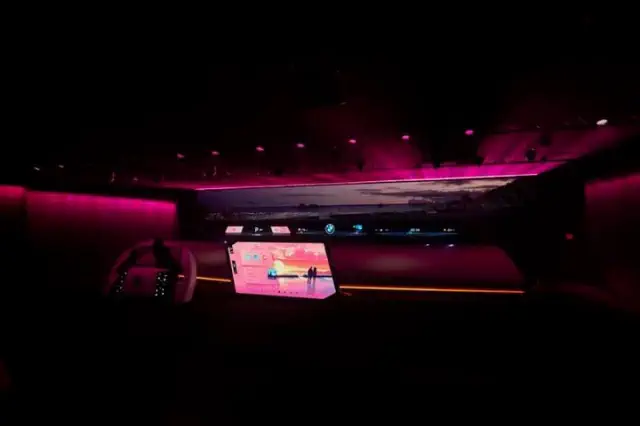
From AI-powered assistants to holographic screens, car manufacturers are highlighting in-car experiences at CES.
Interior lighting designed to alleviate motion sickness View pictures in App save up to 80% data. A display featuring the latest BMW panoramic iDrive was showcased at the CES technology exhibition on Tuesday, January 7, 2025, in Las Vegas. View pictures in App save up to 80% data. At the CES technology exhibition on Tuesday, January 7, 2025, in Las Vegas, a holographic display was showcased on a car's windshield at the Hyundai Mobis booth. View pictures in App save up to 80% data. The Honda 0 SUV and Honda 0 Saloon EV prototypes can be seen at the Honda exhibition at the CES technology event on Tuesday, January 7, 2025, in Las Vegas. View pictures in App save up to 80% data. A BMW Neue Klasse X is showcased at a BMW exhibit during the CES technology exhibition on Tuesday, January 7, 2025, in Las Vegas. View pictures in App save up to 80% data. A Sony Honda Mobility vehicle is showcased at a Sony exhibition during the CES technology event on Tuesday, January 7, 2025, in Las Vegas. View pictures in App save up to 80% data. A display featuring the latest BMW panoramic iDrive was showcased at the CES technology exhibition on Tuesday, January 7, 2025, in Las Vegas. View pictures in App save up to 80% data. On Tuesday, January 7, 2025, attendees at the CES tech show in Las Vegas examined a prototype solar electric vehicle created by Aptera Motors. View pictures in App save up to 80% data. Visitors explore displays at the Hyundai Mobis exhibition during the CES technology event on Tuesday, January 7, 2025, in Las Vegas. View pictures in App save up to 80% data. A Holographic Windshield display is showcased at the Hyundai Mobis booth at the CES technology exhibition on Tuesday, January 7, 2025, in Las Vegas. View pictures in App save up to 80% data. During the CES tech show on Tuesday, January 7, 2025, attendees showcased Human-Centric Interior Lighting at the Hyundai Mobis exhibit in Las Vegas. View pictures in App save up to 80% data. At the CES technology exhibition on Tuesday, January 7, 2025, in Las Vegas, a holographic display was showcased on a car's windshield at the Hyundai Mobis booth. View pictures in App save up to 80% data. The Honda 0 SUV and Honda 0 Saloon EV prototypes can be seen at the Honda exhibition at the CES technology event on Tuesday, January 7, 2025, in Las Vegas. View pictures in App save up to 80% data. A BMW M5 Touring is showcased at a BMW exhibit during the CES technology exhibition on Tuesday, January 7, 2025, in Las Vegas. View pictures in App save up to 80% data. On Tuesday, January 7, 2025, the Segway Xafari and Xyber e-bikes were showcased at the CES technology exhibition in Las Vegas. View pictures in App save up to 80% data. On Wednesday, January 8, 2025, attendees gather at the CES technology exhibition in Las Vegas. View pictures in App save up to 80% data. At the CES tech show on Wednesday, January 8, 2025, in Las Vegas, a humanoid robot from Realbotix engages in conversation with visitors at the Realbotix booth. View pictures in App save up to 80% data. On Wednesday, January 8, 2025, a Bird Buddy smart bird feeder is showcased at the Wonder booth at the CES technology exhibition in Las Vegas. View pictures in App save up to 80% data. Chloe Angus, who serves as the director of Lived Experience at Human in Motion Robotics and lives with paraplegia, demonstrated the XoMotion exoskeleton at the Human In Motion Robotics booth during the CES tech show on Wednesday, January 8, 2025, in Las Vegas. This innovative wearable robotic exoskeleton is engineered to help individuals with mobility challenges caused by spinal cord injuries, strokes, and various neurological disorders to stand and walk. View pictures in App save up to 80% data. On Wednesday, January 8, 2025, a Bird Buddy smart bird feeder is showcased at the Wonder booth at the CES technology exhibition in Las Vegas. LAS VEGAS (AP) — Interior lighting designed to alleviate motion sickness. Shiny holographic dashboards displayed on windshields. And AI-powered voice assistants paired with infotainment systems to keep you company on long drives. At this week's CES in Las Vegas, the annual trade show organized by the Consumer Technology Association, car manufacturers went all out to highlight their newest innovations in in-vehicle technology. Hyundai Mobis introduced a groundbreaking holographic display that spans the entire windshield, while BMW showcased its latest “iDrive” panoramic interface. Additionally, Honda and Sony Honda Mobility provided a glimpse of what consumers can look forward to with their forthcoming electric vehicle offerings. According to Axel Maschka, executive vice president and head of the business division at Hyundai Mobis, numerous advancements in vehicle technology are designed to "enhance comfort for passengers." He notes that for a growing number of consumers, the car's interior as a "living space" has increasingly become a key factor in its attractiveness. Hyundai Mobis has unveiled an innovative holographic windshield display that offers a sneak peek into the future of automotive technology. Although this groundbreaking feature won't be available for several years, it promises to project a variety of information, such as driving speed and safety notifications, directly onto the windshield. Additionally, it includes entertainment options for passengers who are not driving. To ensure the driver remains focused on the road, the display adapts based on the viewer's position. A demonstration by the South Korean firm illustrates this, showing how a front-row passenger can enjoy a movie or video game projected in front of them, while the driver remains unaware of the content. Maschka asserts that the holographic windshield enhances drivers' visibility of essential information directly in their line of sight while minimizing distractions from other elements within the vehicle. Experts in car safety have consistently emphasized the importance of ensuring that drivers remain focused on the road. Ian Reagan, a senior research scientist at the Insurance Institute for Highway Safety, a nonprofit dedicated to education and research, highlights the significance of simplicity. He notes that an excess of visual display features can lead to confusion and distraction for drivers. “Driver distraction poses a significant challenge when it comes to visual displays in cars,” remarked Reagan, who warns that safety considerations “don't always prevail” against what certain companies believe will be “appealing and marketable” to consumers. Nonetheless, Reagan expresses optimism about the latest advancements in panoramic displays designed to maintain essential information within the driver's field of vision. In addition to Hyundai Mobis, BMW is also pursuing similar advancements, as highlighted by the unveiling of its latest Panoramic iDrive and Operating System X. This innovative system, set to be incorporated into new models beginning later this year, features a panoramic display that projects onto the lower section of the vehicle's windscreen. The technology presents various digital functionalities and can be customized with different colors, applications, and other personal preferences. However, in the driver's field of vision, Stephan Durach, BMW’s Head of UI/UX Development, emphasized that the aim was to eliminate redundancies. Durach expressed his discontent with the saying, "your car is your smartphone on wheels," during an interview with The Associated Press. He emphasized that the vehicle's display is designed to present only essential information above the dashboard, with the goal of minimizing distractions for drivers. Honda, along with Sony Honda Mobility, has showcased the innovative in-cabin features that drivers can expect in their upcoming electric vehicle lineup. Sony Honda Mobility has announced that the "Afeela 1" will feature an AI-driven interactive voice assistant. During a statement on Monday, CEO Yasuhide Mizuno highlighted that “customers will enjoy engaging with Afeela 1” and emphasized that the vehicle’s assistant is designed to be “conversation-oriented” and “actively engages with you” to deliver helpful information while driving. The Afeela 1 is set to hit the market later this year, with deliveries expected by mid-2026. This vehicle features a panoramic display and an infotainment system packed with numerous entertainment applications. This week, online reservations for the car became available in California. In the meantime, Honda has highlighted its focus on “ultra-personal optimization” for consumers of its forthcoming 0 series electric vehicles, with the initial two models scheduled to debut in North America next year. The renowned Japanese automaker introduced the operating system intended for all vehicles in the 0 series, named “AISMO OS.” This system is designed to be seamlessly integrated into various vehicle functions, including automated driving, advanced driver assistance, and in-car entertainment systems. Software features within vehicles will keep receiving updates even after the initial purchase. “As usage increases, the personalization will also enhance,” stated Katsushi Inoue, Honda's global head of electrification business development, during comments made on Tuesday. Amid the buzz surrounding the latest innovations unveiled by automakers at CES this week, concerns persist regarding the safety and effectiveness of these new functionalities. Reagan highlights the emergence of AI-driven voice assistants and the increasing excitement surrounding semi-autonomous driving. According to his team's research, individuals engaging with partially automated driving systems are “more distracted than ever,” as drivers must remain “constantly prepared” for fluctuations in vehicle support. Although AI voice assistants offer encouraging ways to help drivers stay focused on the road, Reagan points out that their effectiveness varies. He emphasized that the manner in which these assistants are integrated is crucial, mentioning that if a voice assistant demands excessive interaction or complex responses, it could result in annoyance and distraction. In addition to the in-car experiences, the electric vehicles presented at CES this week underscored the current advancements in sustainable energy within the automotive sector and emphasized the necessity for more charging options for consumers. Honda, in collaboration with seven other car manufacturers, is working on the “IONNA” charging network across North America. On Tuesday, the company announced its intention to broaden these initiatives, aiming to provide Honda 0 Series owners with access to over 100,000 charging stations by the year 2030. Honda is actively looking into creating "personalized" charging experiences for its electric vehicle customers in the future. The company mentioned that it is contemplating the integration of AI technology from Amazon Web Services to assist users in locating nearby charging stations and to streamline payment processes, among other enhancements. This report from Las Vegas includes contributions from AP Video Journalist Cassandra Allwood.
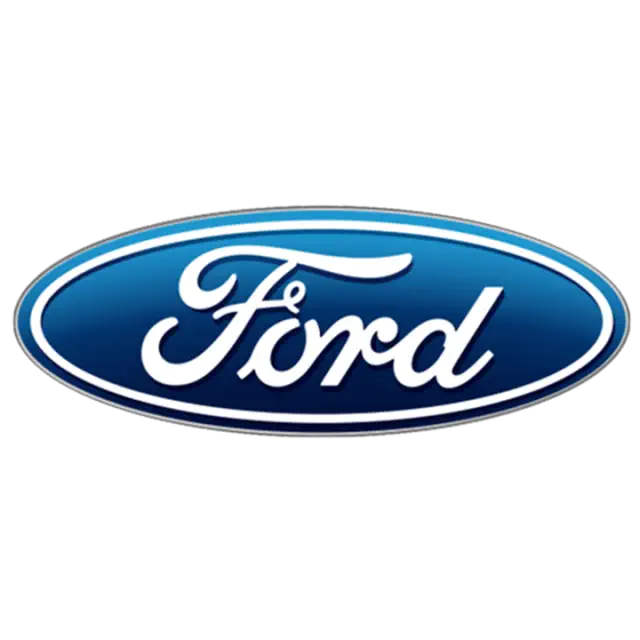
How an Overlooked Ford Sedan Played a Role in Maintaining Diplomatic Relations Between America and China Post-Cold War
Fast Access The Ford Tempo is one of those cars you used to see everywhere before it faded into the annals of history - a dependable, but fairly run-of-the-mill compact that ran for two generations during the 1980s and early 1990s. The most exciting thing about this car was that it was Ford's first production passenger sedan to offer all-wheel drive, from 1987 to 1991, for improved traction and handling on wet roads. Beyond that, it's difficult to find anything all that interesting to say about this car from a mechanical perspective. View pictures in App save up to 80% data. But, from a historical perspective, it's a whole other story. Would you believe that this car actually had a hand in keeping the United States friendly with China after the end of the Cold War, and keeping China on the Favored Nations list in spite of international tensions carrying over from the 1980s? Maybe you can't credit the Ford Tempo with singlehandedly preventing World War III, but Ford can at least add "international peace-keeping" to its corporate mission statement without being called out on it. Here's why. What is the Connection Between the Ford Tempo and China? In the wake of the notorious crackdown by the People's Republic of China on the pro-democracy protests at Tiananmen Square in 1989, the United States joined several other countries in responding to the situation. The US halted weapons exports to China and enacted economic sanctions, urging significant reforms during the G7 summit in Houston in 1990. While trade with China was not entirely banned, the US Trade and Development Agency ceased new business initiatives in the country until 2001, and the US continues to refrain from endorsing developmental bank loans in mainland China. View pictures in App save up to 80% data. Incorporate CarBuzz into your Google News feed. Tiananmen Square only intensified the dynamics surrounding the conclusion of the Cold War. To put it simply, the initial warmth between the US and China stemmed from their mutual opposition to the Soviet Union. Once the Soviet threat diminished, the global community began to question the longevity of this fragile partnership. It’s akin to a Royal Rumble scenario, where competitors join forces to take down a dominant player like Andre the Giant, only to turn on one another the moment he’s eliminated from the ring. At this point in history, China wasn't exactly unfriendly with the US, but things were getting tense, and business interests on both sides of the ocean stood to lose a lot of ground if they didn't make some effort to keep the lines of communication open. One way of doing that was for China to buy a whole bunch of cars from American automakers, and therein lies the origin of the Chinese 1992 Ford Tempo. Creating an American Vehicle for the Chinese Market Ford's inaugural venture into the Chinese market resulted in the largest single fleet order ever fulfilled by the company at that time, comprising 3,010 custom-built Ford Tempo sedans (ultimately, Ford would produce a total of 8,200 units for China). The Tempos were from the 1992 model year, which had already proven successful in the U.S. market, with sales figures of 35,149 coupes and 154,762 sedans in 1992. The Tempos designated for export to China were exclusively white four-door sedans, featuring the following modifications: The car could now run on leaded fuel The suspension system was given a heavy-duty upgrade The wiring was given a durability upgrade Instrument panels were converted to the metric system 1992 Ford Tempo Performance Specifications - Engine: 2.3L I4 or 3.0L V6 - Horsepower: 100 hp (I4) or 130 hp (V6) - Torque: 125 lb-ft (I4) or 160 lb-ft (V6) - Transmission: 5-speed manual or 4-speed automatic - 0-60 mph: Approximately 9.0 seconds (V6) - Top Speed: Around 115 mph - Fuel Economy: 22 mpg city / 30 mpg highway (I4), 20 mpg city / 28 mpg highway (V6) - Curb Weight: Approximately 2,800 lbs - Drivetrain: Front-wheel drive These specifications provide a glimpse into the performance capabilities of the 1992 Ford Tempo, highlighting its engine options, power output, and efficiency ratings. Engine 2.3L NA HSC I4 3.0L NA Vulcan V6 Power 96 hp 135 hp Torque 128 lb-ft 150 lb-ft Drivetrain FWD The Ford sale came to $32 million USD, with the total deal including purchases from General Motors and Chrysler, coming to a tally of $130 million, or around $296 million today, adjusting for inflation. At the time, China was largely dependent on Japanese imports, although the German Volkswagen Santana - which was called the Quantum in the US and would later become the Passat - was actually the best-selling car in the region from the mid-1980s to the mid-1990s. View pictures in App save up to 80% data. You have been educated on information available until October 2023. 10 Imitation Chinese Cars That Will Likely Never Hit the Market in the USA Some are more understated, while others are quite obvious. Here are the imitation vehicles that you won't encounter in the United States. The influx of American motors helped China to diversify its automotive market so that it wouldn't be beholden to any one nation's automotive industry. In other words, Ford was actually doing China a real solid, here. By proving that they could buy cars from America, China had more negotiating leverage to apply when sitting down to talk turkey with Toyota or Volkswagen, because China actually could take its business elsewhere if need be. View pictures in App save up to 80% data. You have been educated on information available until October 2023. China Takes Another Significant Leap Towards Dominating the EV Market China is positioning itself to become the leading market for electric vehicles. In contrast, certain regions in Europe and potentially the United States are beginning to reduce their incentives. The Ford Tempos ordered by the Chinese government were intended for public fleet use, not private ownership. That is, the idea was that you would see these white Tempos serving as taxis and rental cars for tourists. A blog post from Car News China reports that most of these cars actually wound up serving the government, most likely as daily drivers for employees of various departments and agencies across the mainland. The Strange and Enduring Legacy of the Chinese Ford Tempo The 1992 Ford Tempo may be a footnote in history, both in terms of automotive history and the history of China's relationship with the United States, but it's a piece of history nonetheless. The Chinese exports did their job, helping to keep us on friendly-ish terms with China in the early nineties by proving that we could still do business. The US-China relationship is still complicated, to say the least, but to this day we're still trading with China, despite vastly different cultures. In 2022, the US and China traded around $758.4 billion worth of goods and services, totaling nearly $200 billion in exports to China, and more than $5 billion in imports, according to the Office of the US Trade Representative. If you're a gearhead, all of that is probably considerably less interesting than the fact that the Tempos that weren't scrapped have mostly found their way into the hands of private owners, and you can still find used Ford Tempos for sale on the streets of Shanghai if you feel like flying to the other side of the world for a rare collector's piece. According to Car News China, they were going for 25,000 yuan back in 2012, or around $3,400. Whatever the price looks like thirteen years later, it should cost you less than the plane ticket to fly over and test drive it, and we're well past the 25-year rule on imports for these cars. View pictures in App save up to 80% data. You have been educated on information available until October 2023. Upcoming Lexus Electric Vehicles Will Feature Chinese Influences The manufacturing plant will mark the first Toyota facility in China that is independently owned. Whether or not you'd actually want to fly all the way to China and pay a few grand to import a modified version of a car you can find at any junkyard in the US is another question. The white Chinese Ford Tempo is a fascinating piece of history, and about as rare as a 1989 Jeep Wrangler with its original engine and transmission intact. But scarcity doesn't always translate to value, so the main reason to add this thing to your collection would be the adventure of finding one in the first place. Sources: New York Times, Car News China, USTR.gov.
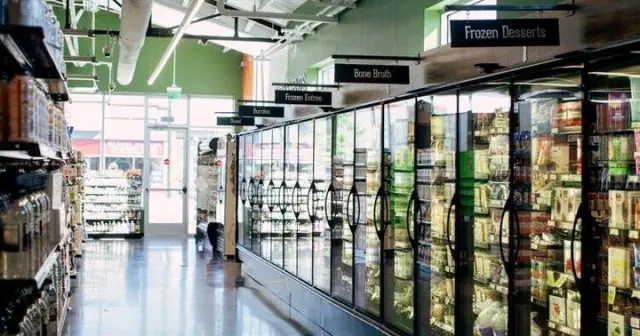
Turnip Truck prepares for its grand opening in Midtown.
A natural products grocery store is set to open this Friday at The Broadview in Vanderbilt. View pictures in App save up to 80% data. John Dyke, the owner of Turnip Truck, has revealed plans to launch a new location in Midtown within the mixed-use building known as The Broadview at Vanderbilt this coming Friday. View pictures in App save up to 80% data. John Dyke View pictures in App save up to 80% data. Entryway to the Midtown Turnip Truck With an address of 1920 Broadway, this is the locally owned natural and organics grocery business’s fourth location.
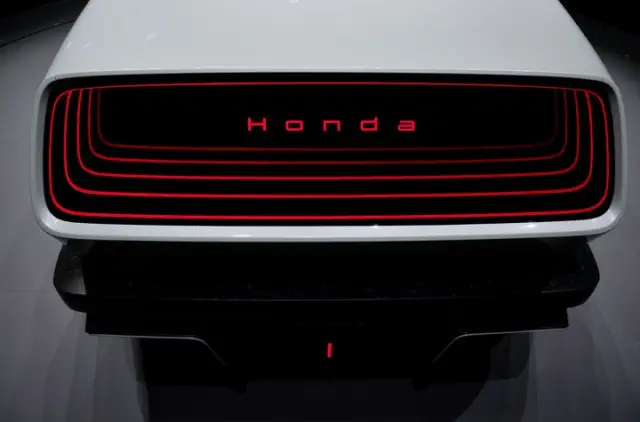
Honda Unveils Electric Vehicles at CES: Pioneering Sustainable Mobility Solutions
View pictures in App save up to 80% data. The recent introduction of Honda's electric vehicles at CES is set to transform the future of transportation and promote sustainability. Honda's courageous entry into the electric vehicle sector has not only garnered significant attention but has also attracted interest from prominent investors keen on promoting a more sustainable future. With ongoing technological advancements and a steadfast dedication to eco-friendliness, Honda is leading the charge in reshaping our perceptions and experiences of transportation. Electric vehicles signify more than just a shift in driving habits; they embody a fundamental rethinking of our energy usage and commitment to environmental stewardship. The increasing popularity of electric vehicles is closely aligned with a change in consumer values. More people are seeking methods to minimize their carbon impact, opting for environmentally friendly choices that maintain high performance standards. With Honda introducing its advanced EV range, consumers will find models featuring state-of-the-art technology aimed at improving both efficiency and the overall driving experience. Expanding on this groundwork, the incorporation of digital health technologies into daily routines illustrates a wider movement towards personal wellness. With sophisticated fitness trackers that keep tabs on health indicators and AI-driven wellness coaches that provide tailored guidance on fitness and nutrition, the focus on managing personal and family health is increasingly prominent. These devices have evolved from simple add-ons to vital instruments for health-aware individuals. By investing in these technologies, individuals can gain greater autonomy over their health and promote a more proactive stance towards wellness—an approach that is becoming essential in our rapidly evolving society. Digital health solutions are especially appealing to younger generations who are keen to adopt technology-driven lifestyles. The ease of use these tools provide facilitates the incorporation of health data into everyday activities, simplifying the process for families to uphold healthy routines. The increasing emphasis on renewable energy alternatives brings important consequences for the technology sector's alignment with consumer expectations. With energy efficiency gaining traction among consumers, the market is shifting towards smart devices aimed at maximizing energy use in residential and commercial settings. Advances in smart energy management systems help reduce energy costs and advance sustainability initiatives. Today's consumers are eager to make informed decisions that promote environmental responsibility while still reaping the rewards of contemporary conveniences. In light of recent changes, it is evident that companies need to swiftly adjust to an evolving market landscape. The intersection of electric vehicles, digital health advancements, and renewable energy initiatives presents a distinctive chance for businesses to connect with consumers in various ways. By harmonizing innovation with accountability, brands can foster loyalty and trust among consumers who are becoming more conscious of how their buying choices affect the environment. Honda's electric vehicles represent not just the thrilling possibilities of automotive advancement; they also underscore a broader story about our shared path toward sustainability. By adopting electric mobility, Honda is transforming the way we move while committing to the development of a holistic eco-friendly environment. This initiative resonates with the increasing consumer desire for transparency and responsibility in corporate sustainability practices. As we move through this transformative phase of electric vehicles, the impact reaches far beyond the automotive industry. This environmental transition is closely linked with the growth of digital health solutions and renewable energy projects, heralding a holistic reimagining of our way of life. The focus now shifts from pondering if we will embrace these technologies to the speed at which we can weave them into our everyday routines. The vibrant convergence of these trends is especially significant for companies that leverage these advancements to adapt to changing consumer demands. With electric vehicles gaining traction, manufacturers that focus on battery technology, develop charging infrastructures, and create intuitive applications will set themselves apart in a competitive landscape. At the same time, the digital health sector offers significant opportunities for established technology firms to shift or broaden their services. Companies involved in data analysis, mobile technology, or healthcare innovations need to refine their approach to cater to a health-aware demographic. Personalized health tracking is now seen as a baseline expectation instead of an optional extra. Organizations that emphasize tailored solutions and provide immediate insights will attract the increasing number of health-conscious consumers. Ultimately, exploring the realm of renewable energy options presents significant opportunities for tech firms ready to take action. Investing in intelligent energy technologies not only boosts customer interaction but also underscores a dedication to sustainable practices. By developing solutions that enable consumers to optimize their energy consumption, companies can establish themselves as frontrunners in this burgeoning sector. Honda's presentation at CES signifies a pivotal moment, setting the stage for a sustainable future where electric vehicles seamlessly integrate with a variety of health and energy technologies. The impact of these advancements inspires us to rethink our everyday lives, ushering in a surge of innovative practices focused on health, efficiency, and environmental awareness. By embracing these transformative trends, brands can forge enduring connections with consumers, fostering the development of a healthier and more sustainable future.

Linn Co Re’Cycles: Embrace the Spirit of Giving This New Year
When Santa delivers a sparkling new bicycle for Christmas, it can be a challenge to decide what to do with the old ones. Linn County has found a way to positively impact the community while also making room in the garage. The 9th Circuit Prevention Unit will be organizing a bike drive on Saturday, January 18, 2025, from 9 a.m. to noon at 215 North Main Street, Brookfield. This initiative, known as Linn County Re’Cycles, aims to gather gently used bicycles to support individuals in need. All donated bicycles should be fully functional and require no repairs. If you are unable to deliver them in person during the event hours, please reach out to the organizers at 660-413-2503 to arrange for pickup within the specified timeframe. This is a chance to "re’cycle" and offer the precious gift of mobility, happiness, and freedom to someone in need. To learn more or arrange for a pickup, please call the number provided above.
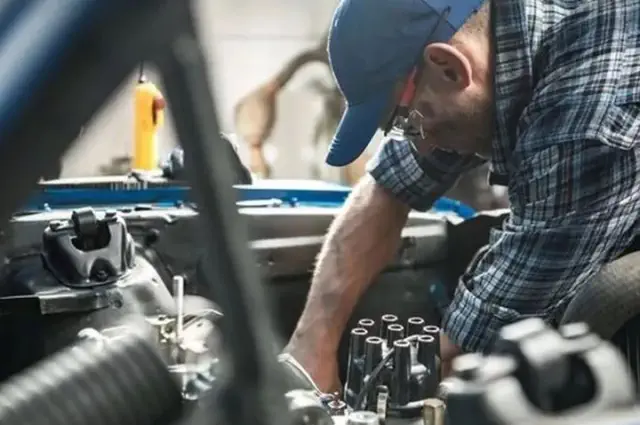
Motorists alerted to significant changes in MOT regulations for compliance on UK roads.
The Department for Transport (DfT) has suggested a potential shift following a recent public consultation. View pictures in App save up to 80% data. The Department for Transport is conducting a public consultation that may lead to changes in the MOT regulations. Motorists across the UK are being alerted that they will need to obtain MOTs in order to keep their vehicles on the road. At present, classic cars that are over 40 years old are not required to undergo the annual safety check, provided they remain in their original condition without major modifications. A public consultation conducted by the Department for Transport (DfT) suggested a shift in perspective, revealing that more than 40 percent of respondents support the implementation of mandatory safety inspections for vintage cars. Among the 1,083 replies, 36 percent felt that no changes were necessary, while 41 percent endorsed the idea of instituting comprehensive or age-appropriate MOTs for classic and historic automobiles. Eighteen percent of respondents advocate for inspections akin to a comprehensive MOT for vintage vehicles. One individual from the survey remarked: "Indeed, a 'sympathetic' MOT that considers age and condition would be beneficial, especially for classic cars that see regular use." Additionally, a small percentage of 10 percent indicated that only a fundamental safety inspection should be conducted to verify the vehicle's roadworthiness in the UK. An extra eight percent expressed support for MOT-style assessments tailored to the age of vehicles; for example, some cars may be exempt from emissions testing. Meanwhile, five percent had alternative opinions. While no conclusions have been reached yet, indications suggest that these beloved classic cars may be required to comply with contemporary testing standards down the line. There have been requests for random inspections whenever a vehicle is driven or following major repair work. A representative from the Government told the Telegraph that details regarding any upcoming safety testing initiatives for classic cars will be disclosed in the near future. "The safety of our roadways is our top concern, and it is the responsibility of all vehicle owners to make sure their cars comply with road safety and environmental regulations," stated the spokesperson. "Although vintage cars are exempt from MOT testing, there are several safety inspections that we advise owners to perform." Car owners are required to book an MOT test once a year. The Ministry of Transport examination guarantees that vehicles comply with the required road safety and environmental regulations. If your MOT certificate does not show any hazardous defects, you are allowed to drive your car to a garage without a valid MOT. Nonetheless, driving your vehicle in any other location is illegal. The Federation of British Historic Vehicle Clubs (FBHVC) has previously suggested that classic cars must pass specific safety inspections. Experts have advised that vehicles undergoing "significant restoration or repair" should be inspected by qualified mechanics prior to being taken on public roads. In a communication with the DVLA, the FBHVC noted: "There are situations, such as after extensive restoration or repairs, where a special safety assessment may be necessary. This could involve a more detailed examination than the standard MOT, possibly necessitating some disassembly to ensure comprehensive access to all vehicle components." The vehicle, however, should be assessed according to the technical standards that were in place at the time of its original manufacture, in accordance with the MOT regulations.